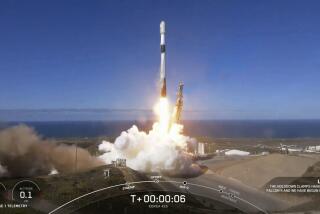Radar-Imaging Company Sees Niche in Dark
- Share via
After U.S. missiles bombed a suspected terrorist camp in Afghanistan last month, cloud cover and darkness prevented the world from seeing the full impact of the attack for several days. But if Radar1 had been orbiting the Earth, detailed images of the destruction could have been made available in as little as 12 hours.
So say executives at RDL Space Corp., the Culver City company behind Radar1. RDL Space plans to launch the first commercial satellite that uses radar to see the planet’s surface through clouds, bushes and even darkness.
Using a technology first developed in the 1930s that helped Britain’s Royal Air Force defeat the Germans during World War II, RDL Space hopes to carve itself a niche in the growing market for satellite images, which for decades has been dominated by electro-optical pictures, which are prized for their photograph-like quality.
Electro-optical satellites work essentially like giant cameras, sensing and recording light to produce full-color pictures. Radar, on the other hand, relies on reflected radio waves, which can’t see colors but can reveal the shape of objects based on how the waves bounce off them.
That means a radar satellite doesn’t depend on daylight or clear weather to take an image. It also means that radar sensors can identify water, metal and other particularly reflective surfaces.
Altogether, those capabilities should make a radar satellite a valuable tool for purposes as diverse as tracking oil spills, documenting illegal fishing and measuring the moisture in agricultural fields, said Birendra “Raj” Dutt, president and chief executive of Research & Development Laboratories, RDL Space’s parent company.
The Jet Propulsion Laboratory in Pasadena launched the first radar-sensing satellite in 1978 to monitor the oceans. Today, the governments of Canada and Japan and the European Space Agency operate radar-sensing satellites of their own, and JPL is preparing to launch its third radar satellite--to measure winds over the oceans--in November.
But RDL Space’s Radar1 is aiming to become the first commercial satellite to provide radar imaging. In June, the company won the first U.S. license for a commercial radar satellite from the National Oceanic and Atmospheric Administration, and it’s now applying for another critical license from the Federal Communications Commission.
When it becomes operational in 2001, Radar1 will be able to produce an image of almost any place on Earth precise enough to make objects as small as 5 meters (about 16 1/2 feet) across recognizable, and it will deliver that image to the customer within 12 hours, Dutt said. The satellite will have the capability to see things as small as 1 meter (about 3 feet, 4 inches), but will need a waiver from the U.S. government to sell images with such high resolution, he said.
To make an image, Radar1 will beam 2,000 to 4,000 radio pulses per second--the more pulses, the better the resolution--from a transmitter for one to three seconds. Each pulse will hit the Earth’s surface and bounce off, with some portion of the pulse returning to the satellite. Radar1 will record information about the shape of the returning radio waves and send that data to one of several planned ground-link stations on Earth.
From there, the data will travel via fiber-optic cable to a Radar1 control center planned for northern Virginia. Computers will translate the information about the shape of the pulses into a corresponding shade of black, white or gray. Smooth and metallic surfaces that are highly reflective register as black, while rough surfaces that completely scatter the radio waves will show up as white.
“The signals tell you the different features in the terrain and features on the objects they’re hitting,” said Chris Haakon, chief executive of Autometric, the Springfield, Va., firm that will run the Radar1 control center.
Images Could Offer Valuable Information
The computers produce an image that looks like a black-and-white photograph.
But “the image is just the starting point,” Dutt said. “It’s the information in the image that’s important.”
Reading a satellite image isn’t as simple as reading a newspaper. A nuclear testing site in India would be difficult for a layman to spot, but it would be recognizable to an intelligence officer who knows what telltale signs to look for, Dutt said. Autometric will use its cadre of image analysts, built up during decades of government work, to interpret the images.
Depending on customer demand, some images will also get “value-added processing,” such as colorization to highlight certain characteristics, Haakon said. Images can also be warped to look as if they were taken from a different angle, blended with other images or adorned with contour lines and labels, he added.
If Radar1 takes off, it will be one of the first big commercial products for privately held Research & Development Laboratories. Five years ago, most of the company’s work was defense-related. But with military budget cuts, Dutt decided to focus on about a dozen commercial and dual-use technologies. Radar1 is one of the most promising, and in October 1996, RDL Space was spun off by RDL into a separate company.
RDL has spent a few million of its own dollars--along with tens of millions of dollars from the U.S. government--developing Radar1 and has tested its radar-imaging technology on data gathered from airplanes, blimps and even the space shuttle, Dutt said. It now claims half a dozen of RDL’s 150 employees.
Launching a radar satellite is “a natural growth area” for RDL because its strong suit has historically been in radar detection and processing, said Jon Kutler, president of Quarterdeck Investment Partners, a Los Angeles investment bank that focuses on the aerospace industry.
“The question is, for their size and their growth rate, can they pull it off given the large market they’re trying to play in?” Kutler said. “If they can pull this together, it may be a turning point for them.”
Dutt is now shopping around for a company to build Radar1, and RDL Space is close to an agreement to have Los Angeles-based radar specialist Northrop Grumman Corp. produce the radar payload and the Earth-based image-processing chain, according to both companies. Seattle aerospace giant Boeing Co. is also exploring options for entering the radar satellite business and may link up with RDL Space, according to Boeing spokesman Bob Smith.
But it will be up to Dutt to create commercial demand for radar satellite images among customers who are used to buying electro-optical pictures.
The timing may be ideal: The overall market for space-based remote-sensing data currently stands at $139 million and is forecast to grow an average of more than 30% per year, to $698 million by 2004, said Ron Stearns, an analyst with Mountain View, Calif.-based market research firm Frost & Sullivan. Electro-optical satellites represent the bulk of that, but customers are eager for a new product that is impervious to weather, and the first company to launch a radar satellite that can make images with 5-meter resolution “will be well-positioned to dominate this segment through 2004 and beyond,” he said.
Tools of Espionage?
Some of RDL Space’s biggest potential customers are foreign governments that can’t afford to maintain their own full-time satellites, said Liam Weston, RDL Space’s vice president of business development. But selling images to them raises questions about national security.
“One of the many hypotheticals is, ‘What if Saddam Hussein hires RDL?’ ” said Charles Wooldridge, remote-sensing licensing coordinator for the National Oceanic and Atmospheric Administration in Silver Spring, Md. “It has to do with our ability to control the imagery.”
On the flip side, Radar1 could serve as a giant “candid camera” in the sky, catching bad guys as they dump oil into the oceans, cross U.S. borders illegally or fish in restricted waters, Dutt said.
In all likelihood, neither scenario will come to pass soon, said Kevin O’Connell, a senior international policy analyst with Rand Corp. in Washington.
“We don’t have the precision today to do either the good stuff or the bad stuff that everybody fears,” he said. “No one’s going to blow up the world with a [high-resolution] image from space.”
Times staff writer Karen Kaplan can be reached via e-mail at karen.kaplan@latimes.com.
(BEGIN TEXT OF INFOBOX / INFOGRAPHIC)
Picture of Progress
RDL Space in Culver City plans to become the first company to launch a commercial satellite that uses radar to create images of the Earth. The satellite, called Radar1, will be designed to discern things as small as 5 meters long--perhaps even smaller. Unlike most satellites, which take pictures more or less like a regular camera, a radar satellite can see through clouds and bushes and can even create images in the dark. Here’s how it will work:
1. Radar1, orbiting above the Earth, will beam thousands of pulses in less than 3 seconds to a location that a customer wants an image of
2. The pulses bounce back and are recorded by the satellite. Depending on the shape of the ground, the pulse will return with a different intensity
3. The data are sent to the nearest ground-link station on Earth and transferred to a processing center outside Washington
4. Computers use mathematical algorithms to convert the information in the returned signals into a black-and-white image. Black surfaces are smoothest and white surfaces are the roughest.
5. The image is delivered to the customer, probably over the Internet. The entire process takes less than 12 hours.
Source: RDL Space
More to Read
Inside the business of entertainment
The Wide Shot brings you news, analysis and insights on everything from streaming wars to production — and what it all means for the future.
You may occasionally receive promotional content from the Los Angeles Times.











